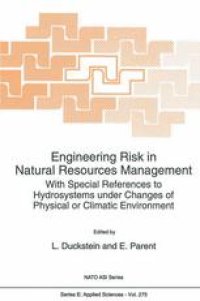
Ebook: Engineering Risk in Natural Resources Management: With Special References to Hydrosystems under Changes of Physical or Climatic Environment
- Tags: Environmental Management, Atmospheric Sciences, Hydrogeology, Systems Theory Control
- Series: NATO ASI Series 275
- Year: 1994
- Publisher: Springer Netherlands
- Edition: 1
- Language: English
- pdf
The purpose of this paper is to present a methodology for estimating space-time stochastic properties of local climatic factors reflecting global climate change. Specifically, daily precipitation amount and daily mean temperature are considered and illustrated with application to the state of Nebraska, U. S. A. Furthermore, a drought index with and without global climate change is examined. The magnitude and consequences of regional response to anticipated climatic changes are uncertain (Houghton et al. , 1990). Typical questions to be answered are: can time series of hydrological events or 10cal climatic variables such as daily temperature be conditioned in scenarios of future climate change and if so, how can this be utilized ? Can extreme historical drought events be reproduced by a stochastic hydroc1imatological model ? Can such a model be used with General Circu1ation Model (GCM) outputs to evaluate the regional/local effects of climate change scenarios? The approach presented in this paper is an extension of the usual analysis of regional hydrometeorological impacts of climate change: we propose to examine time series of GCM produced daily atmospheric circulation patterns (CP), thought to be relatively accurate GCM output to estimate local climatic factors. The paper is organized as follows. First, daily CPs are classified and analyzed statistically, first for historical and then for GCM produced data. Next, the height of the 500 hPa pressure field is introduced as an additional physically relevant variable influencing local climatic factors within each CP type.
This book provides a system framework to observe, detect and monitor changes in geophysical time series for the purpose of managing natural -- mostly water -- resources. The institutional aspects of risk are considered to be an integral part of the management system. Original and novel features include the definitions of institutions, the development of forecasting and control schemes under non-steady inputs and the point of view of practitioners, all embedded in a common framework for reliability and risk analysis.
The first three chapters provide the model-based systems design and control framework, and then the methodology for physical and stochastic analysis of the changing forcing function and hydrometeorological input series. The next two chapters deal with consequences of climate change, in particular, its potential effect on river flows, sea level rise, water quality and extreme floods respectively. The last two chapters develop engineering decisions, policy considerations and case examples. Whereas most reliability and risk analysis books have dealt with steady-state conditions, we are specifically focusing on the difficult problems of observations and management to be done in a non-stationary environment.